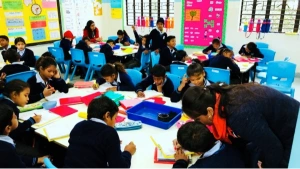The educational landscape is undergoing a dynamic shift, with international education trends influencing how we learn and adapt to a changing world. Let’s look at some significant trends and how they’re impacting international education.

International Educational Trends
Let’s dissect the term “international education trends” to comprehend its various aspects:
International Education:
This refers to educational possibilities that transcend national lines and involve a variety of learning experiences.
- Studying abroad is pursuing academic programs in a different nation than your own, which provides cultural immersion, exposure to new perspectives, and potential professional benefits.
- Online learning entails accessing educational resources and courses provided by worldwide universities, allowing for flexibility and global learning opportunities.
- International exchange programs include participating in short-term academic or cultural exchanges, fostering intercultural understanding, and broadening horizons.
- Joint degrees or collaborations: enrolling in programs or research collaborations between institutions from different countries, gaining unique expertise and international recognition.
Related: International Students’ Mental Health Support

Trends:
These are patterns, developments, or directions that emerge within a field over time, indicating significant changes or evolving priorities. In international education, trends might focus on:
- Pedagogy and teaching methods: Innovative approaches like project-based learning, technology integration, or personalized learning are gaining traction.
- Curriculum and learning outcomes: emphasis on skills development, global citizenship, and sustainability being reflected in educational programs.
- Policy and governance: International frameworks like the Sustainable Development Goals (SDGs) influence education policies and approaches.
- Technology and innovation: The use of AI, virtual reality, and online platforms is transforming learning experiences and accessibility.
- Student demographics and mobility: increased student mobility, growing demand for specific skills, and diversification of student populations.
Therefore, international education trends encompass the evolving patterns and developments within the field of education that cross national borders. These trends influence teaching methods, curriculum content, policy frameworks, technological applications, and student experiences in a globalized context.
Related: International Baccalaureate (IB) Program: A Global Education Perspective

How Education Has Transformed The World
Education has been a monumental force in transforming the world in countless ways, impacting individuals, societies, and the global landscape as a whole. Here are some key areas where education has played a transformative role:
Individual Empowerment and Social Mobility:
- Promoting literacy and numeracy: Education equips individuals with fundamental skills and knowledge, empowering them to participate actively in society, access information, and make informed decisions. This, in turn, lays the foundation for social mobility and upward economic movement.
- Developing critical thinking and problem-solving skills: Education fosters analytical thinking, problem-solving abilities, and decision-making skills, empowering individuals to navigate complex situations, solve challenges, and contribute meaningfully to their communities.
- Nurturing creativity and innovation: Education encourages creative expression, innovation, and entrepreneurship, leading to technological advancements, artistic contributions, and solutions to pressing issues.
Related: Creative Ways to Save Money on Textbooks for Students
Development and Economic Growth:
- Skilled labor: A population with a high level of education produces a skilled labor force that promotes economic expansion, advances technology, and increases a country’s ability to compete internationally.
- Innovation and entrepreneurship: Education fosters an innovative and entrepreneurial culture that generates new companies, sectors of the economy, and employment possibilities.
- Decreased poverty and inequality: One effective strategy for lowering poverty and inequality is education. Better livelihoods, higher earning potential, and better social mobility are all results of expanded access to education, especially for females and members of underprivileged communities.
Related: Budget-friendly Transportation Options for College Students
Political Participation and Democracy:
- Informed citizenry: Education fosters informed and engaged citizens who can critically evaluate information, participate meaningfully in democratic processes, and hold their leaders accountable. This strengthens democratic institutions and promotes good governance.
- Promoting peace and tolerance: Education bridges cultural divides, promotes understanding and tolerance and fosters peaceful coexistence within diverse societies. It can also equip individuals to advocate for human rights, social justice, and peaceful conflict resolution.
- Combating extremism and radicalization: Education can be a powerful antidote to extremism and radicalization by providing individuals with critical thinking skills, an understanding of different cultures, and alternative perspectives.
Related: Balancing Part-time Job Income and Full-time Studies: A Comprehensive Guide
Global Health and Environmental Sustainability:
- Environmental action and awareness: Education is essential for encouraging sustainable habits, bringing attention to environmental challenges, and enabling people to take on the role of responsible global stewards.
- Encouraging health and well-being: Education is essential for fostering good hygiene habits, illness prevention, and healthy lifestyles, all of which lead to better health outcomes for both individuals and communities.
- International collaboration and collective action can be encouraged through education by fostering a feeling of global citizenship and shared responsibility for addressing global issues like poverty, pandemics, and climate change.
Education’s transformative impact extends far beyond individual knowledge acquisition. It empowers individuals, drives economic growth, strengthens democracies, promotes peace and understanding, and fosters a more sustainable and equitable world. The impact of education continues to evolve as the world changes, ensuring its enduring significance as a powerful force for positive transformation.
Related: Teaching Abroad: Your Path To An International Educational Career

The Concept Of Education
“The concept of education” is a vast and multifaceted one, with different interpretations and nuances depending on your perspective. Here are some key dimensions to consider:
- Formal vs. Informal:
- Formal education: traditional classroom settings with structured curriculum, defined learning objectives, and accredited qualifications.
- Informal education: learning happens throughout life, through daily experiences, interactions, self-directed activities, and community engagement.
- Knowledge vs. Skills:
- Knowledge acquisition: Traditionally, education focused on transmitting information and facts.
- Skills development: Modern education emphasizes critical thinking, problem-solving, communication, collaboration, and other essential skills for navigating the 21st century.
- Individual vs. social:
- Individual development: Education empowers individuals with knowledge, skills, and personal growth.
- Societal progress: education fosters informed citizens, a skilled workforce, and social change agents, contributing to a better future for all.
- Process versus content:
- Content-driven: The conventional focus is on certain courses and curricula.
- Process-oriented: emphasizes inquiry, discovery, active learning, and lifetime learning abilities.
- Access and Equity:
- Equal access to high-quality education: Everyone has the right to learn and prosper, regardless of background, gender, socioeconomic situation, or place of residence.
- variety and inclusion: Education promotes inclusivity and celebrates variety by embracing a range of learning methods, aptitudes, and cultural origins.
Related: Smartphone Apps for Efficient Budget Tracking and Financial Planning for Students
Some other concepts of education include:
- Global Perspective:
- Intercultural understanding: Education fosters awareness of different cultures, languages, and perspectives, promoting global citizenship and collaboration.
- Addressing global challenges: Education equips individuals with the knowledge and skills to tackle global issues like climate change, poverty, and inequality.
- Technology and Innovation:
- Integration of technology: Education adapts to technological advancements, utilizing digital tools and platforms for teaching, learning, and communication.
- Personalized learning: Technology enables more individualized learning experiences, catering to diverse needs and learning styles.
- Lifelong Learning:
- Education is not confined to childhood; constant learning, upskilling, and reskilling are crucial in a rapidly changing world.
- Education adapts to evolving needs. Learning opportunities cater to individuals at different stages of life and careers.
The concept of education is constantly evolving, influenced by diverse perspectives, changing societal needs, and technological advancements. Understanding these various dimensions allows us to engage in meaningful discourse and work towards shaping an education system that empowers individuals, contributes to a better society, and prepares us for the challenges and opportunities of the future.
Related: UNESCO’s Role In Shaping Global Education Policies

Best Education System In The World
Unfortunately, there’s no single “best” education system in the world, as the ideal approach depends on several factors like individual preferences, national priorities, cultural contexts, and specific educational goals. Different systems excel in different areas, making direct comparisons complex and often subjective.
However, we can explore some top-performing education systems based on various rankings and metrics:
High-performing countries in international student assessments:
- Finland: Known for its emphasis on equity, student agency, and well-being, Finland consistently ranks high in PISA (Programme for International Student Assessment) scores.
- Singapore: This system emphasizes high academic standards, rigorous testing, and strong teacher training, leading to top PISA scores in math and science.
- South Korea: Similar to Singapore, South Korea focuses on academic achievement and standardized testing, resulting in excellent PISA results.
- Canada: Offering diverse and flexible education options, Canada boasts strong PISA scores and prioritizes critical thinking and problem-solving skills.
Related: Utilizing Student Discounts Effectively for Maximum Savings
Systems praised for specific aspects:
- Estonia utilizes technology effectively for personalized learning and digital literacy development.
- Germany is renowned for its vocational training system that combines classroom learning with practical experience.
- New Zealand champions inclusive education and prioritizes well-being alongside academic success.
- Israel is pioneering innovative STEAM education methods, particularly in computer science and technology.
Related: Affordable and Healthy Grocery Shopping Tips for Students
Aspects to think about outside of rankings:
- Equity and access: Do all students have an equal chance to achieve, regardless of their background?
- Innovation and adaptability: How quickly can the system change to meet evolving requirements and address societal issues?
- Holistic development: Does the system foster social, emotional, and physical well-being in addition to academic skills?
- Teacher support and quality: Do teachers receive enough encouragement, training, and resources?
- Cultural alignment: Does the system reflect the goals and values of the community it is intended to serve?
In the end, an education system that meets the unique requirements and goals of its residents and students and equips them for a happy life and responsible engagement in a globalized world is the “best” one. It may be more effective to concentrate on comprehending several strategies, picking up tips from industry leaders, and customizing them to your particular situation rather than striving for a single ideal.
Related: International Student Insurance Options For Studying In The U.S

Factors Influencing The Aims Of Education
The aims of education are not set in stone but rather shaped by a dynamic interplay of various factors. Here are some of the key influencers:
Philosophy of Life:
- Different philosophies, like utilitarianism, humanism, or critical theory, hold diverse views on the purpose of life and the role of education in achieving it. These views influence the emphasis placed on individual development, social progress, or critical thinking skills.
Views about Human Nature:
- Beliefs about human potential, intelligence, and learning styles impact how education is designed. Some systems focus on standardized instruction, while others prioritize individualized learning and fostering creativity.
Religious Factors:
- Religious teachings and values often influence the content of education, focusing on moral development, spiritual growth, or adherence to specific beliefs. This can shape curriculum choices, teaching methodologies, and the overall ethos of educational institutions.
Political Ideologies:
- Political systems and ideologies have a profound impact on educational goals. Democratic societies might emphasize civic engagement and critical thinking, while authoritarian regimes might prioritize obedience and nationalistic values.
Socio-Economic Factors:
- The economic and social context of a society influences how education is perceived and utilized. In developing nations, education may be seen as a key driver of economic growth and poverty reduction, while in developed nations, it may be viewed more as a means for individual fulfillment and career advancement.
Cultural Factors:
- Cultural traditions, values, and beliefs shape the content and methods of education. Some cultures might prioritize rote learning and memorization, while others value experiential learning and storytelling.
Related: International Schools vs. Local Schools: A Parent’s Guide

Technological Advancements:
- Rapid advancements in technology continuously reshape the landscape of education. The rise of digital tools and platforms opens new possibilities for personalized learning, global collaboration, and access to information, influencing how knowledge is acquired and applied.
Global Issues and Patterns:
- Education systems must address pressing global issues such as inequality, pandemics, and climate change. This could entail introducing global citizenship principles, sustainability education, and the development of critical thinking abilities into the curriculum.
Labor Market Requirements:
- Education systems must change to meet the changing needs of the workforce and provide students with the skills they will need in the future. This could entail emphasizing digital literacy, entrepreneurship, and STEM education to get pupils ready for a changing labor market.
Student Needs and Aspirations:
- Ultimately, education should serve the needs and aspirations of students. This means recognizing individual differences, learning styles, and career goals, and tailoring educational experiences to foster well-rounded individuals prepared to thrive in a complex and dynamic world.
These factors constantly interact and evolve, influencing not only the aims of education but also the curriculum, teaching methods, and overall educational landscape. Understanding these influences is crucial for educators, policymakers, and individuals alike to engage in meaningful discussions and work towards shaping an educational system that is relevant, adaptable, and empowers individuals to reach their full potential.
Related: Resources For Students With Disabilities: Special Education Admission
Conclusion
Adapting to these trends is not without its challenges, requiring flexibility, innovative thinking, and commitment to equity and inclusion. However, embracing these changes holds immense potential to prepare students for a brighter future in a globalized, interconnected world, and equip them with the skills and knowledge needed to thrive in a rapidly evolving landscape.


2 thoughts on “International Education Trends: Adapting To A Changing World”